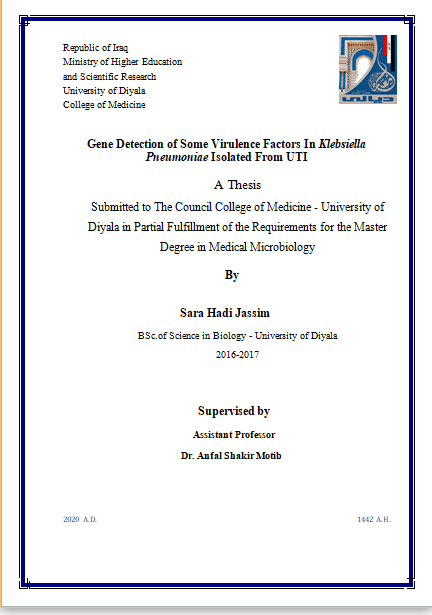Abstract
A total of 160 clinical samples were collected from two
hospitals in Diyala from patients in both sexs, suffering from urinary tract infection of age range between(≤ 10-50) years in the period between (September / 2019 –December / 2019). Out of 160 isolates, 24 identified as Klebsiella pneumoniae depending on cultural, biochemical characteristics, and molecular methods. The remaining bacterial isolates from urine samples were identified as Escherichia coli (45) , Pseudomonas(23), Proteus(27 and Citrobactar(16) isolates.
Regarding to the patients gender, it was found that females had a tendency to get infection more than the males when 20 (83.3%) of patients were females and 4 (16.7 %) of them are males. Moreover, the age group (30-39) were most subjected to the infection of K. Pneumoniae.
The antibiotic susceptibility test showed that all isolates were Multidrug Resistance (MDR) , were high resistant to Ciprofloxacin 24 (100%),Cefotaxime 24(100%) ,Piperacillin 17(70%), Nalidixic acid 12(50%), Tetracycilln 10 (41%), Nitrofurantion8(33%), Chloramphenicol 7(29%) Ampicilln-sulbactam7(29%), Tobromycin4(16%), and Impenem 2(8%).
The organism were identified by using molecular methods, including the DNA extraction and checking with PCR using identified genes, including 16srRNA,and some virulence factor gene such as rmpA and iroN gene .
The DNA sequencing was done to identify the strains of Klebsiella pneumoniae that cause UTI in Iraq especially in Diyala city, the results showed that there are two strains responsible to the UTI in this city, Klebsiella pneumoniae strains D16KP0042 and KPWIQ25. The results of DNA sequencing analysis of 16SrRNA gene from k1 to k24 isolates revealed that k.pneumoniae were (100%).and iro N gene revealed only in 3 isolates(12.5%),while rmp A gene not observed in any isolates.
The prevalence of biofilm producer bacterial isolates was 22(91%) that
7(31%) produced strong, 6(27%) produced moderate and 9(40%) produced weakly biofilm.





